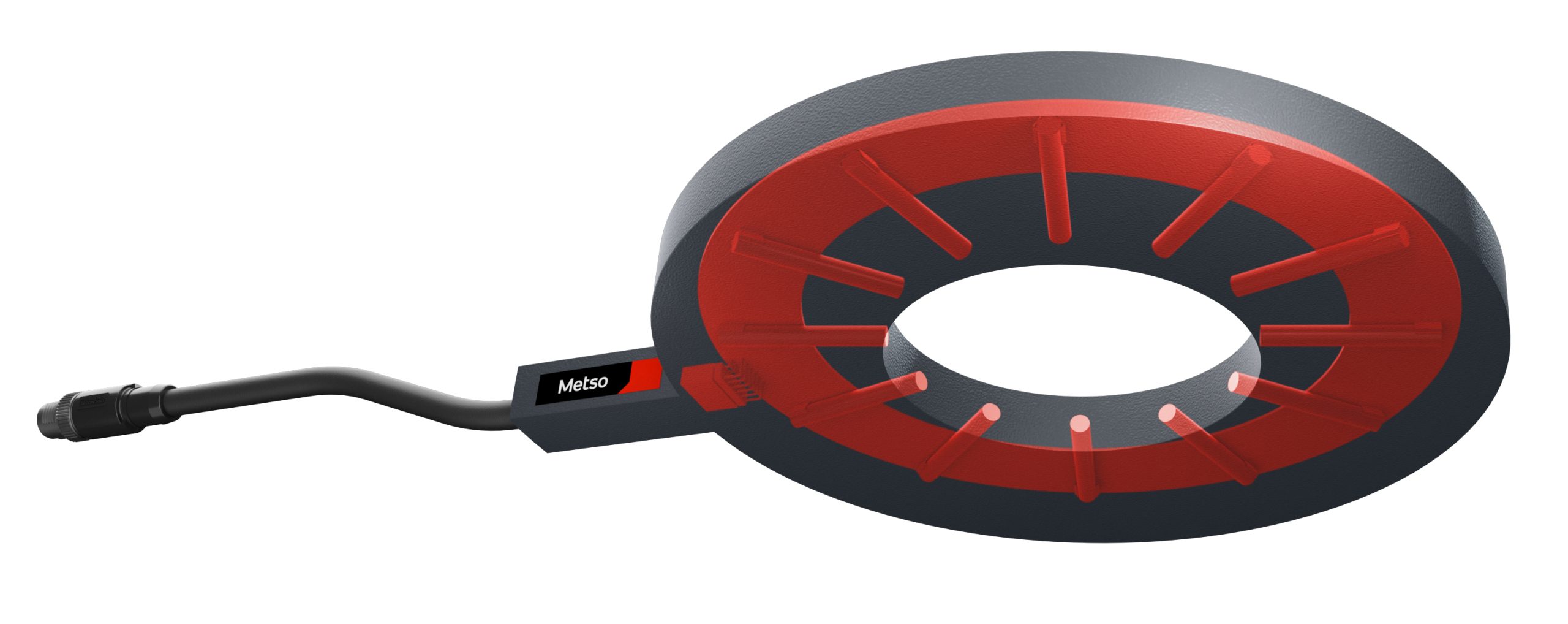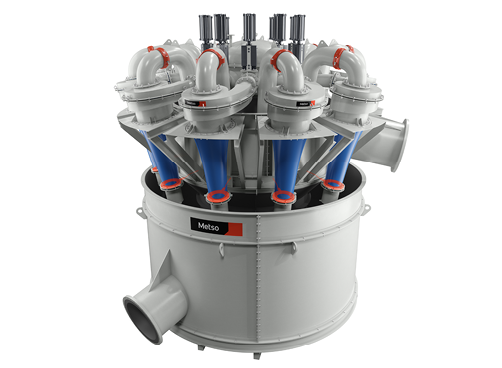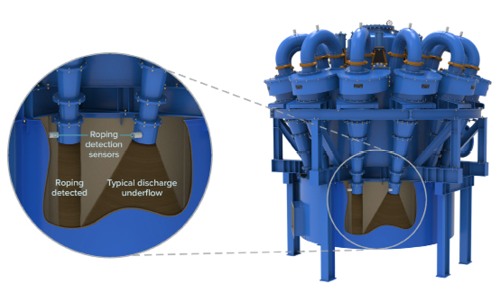Hydrocyclones have been workhorses of mineral processing for over a century.
But how is this venerable technology adapting to the needs of 21st century mining?
By Jonathan Rowland

Digital solutions, such as CycloneSense from Metso (pictured), help detect disturbances and optimize separation performance.
Hydrocyclones have been around for a while; invented in the late 1800s, they were further developed and introduced for mineral processing applications at the Dutch State Mines in Limburg (Netherlands) in 1939. Since then, these machines have become a staple of mineral processing operations due to their ability to separate particles by size, and to do so efficiently, cost-effectively and in high volume.
More than eight decades on from that first application in Limburg, the future hydrocyclones continues to look “bright,” as Ben Klein, product group manager – Hydrocyclones at Metso, told North American Mining.
“High-level wet classification in mining is necessary for efficient size control of particles finer than 1 millimeter in water. There are different methods of wet classification, but when the product size range is 10 µm to 250 µm, hydrocyclones remain the optimal choice.”
One of the key benefits of hydrocyclones is their lack of moving parts. This makes them relatively straightforward to operate. However, it also places much emphasis on the design and selection process to deliver optimum performance. For example, the internal dimensions and geometry of the hydrocyclone, as well as the material from which it is constructed, should be tailored to the specific characteristics of the feed material (i.e., particle size distribution, density, viscosity, abrasiveness, and corrosiveness, etc.), the specific operating parameters (i.e., specific gravity, turbulence, slurry density and pressure), and the desired product output.
Selection of the most appropriate hydrocyclone should balance mathematical modeling of these variables with a practical understanding of how the hydrocyclone will be used over its operating life. It’s also important to consider the hydrocyclone within the complete process, as hydrocyclone performance is fundamentally linked to the performance of other equipment and processes within the circuit.

Hydrocyclones have long been part of mineral processing circuits. The latest designs, such as the Metso MHC Series hydrocyclone (pictured) feature improved internal geometry to deliver improved separation efficiency and capacity.
Operating hydrocyclones: looking into the black box
When it comes to hydrocyclone operation, there is an element of “mystery,” according to Alan Bennetts, global product manager for Washing and Classifying at McLanahan. This comes from “the inability to see what is happening inside.”
However, there are ways the sleuthing engineer can use to “see” inside the hydrocyclone. “Pressure at the inlet can tell you a lot,” continued Bennetts. “It’s an important indicator of where the separation point – also known as the cut point or d50 – will be. Pressure below target will result in a d50 that is coarser than desired; higher pressure will send more fines to the underflow and result in too fine a cut point. Pressure should therefore remain stable to keep a constant cut point, and any sudden changes in pressure should always be investigated.”
Digitalization is helping here. “Being able to monitor the hydrocyclone indicator, such as inlet pressure, allows operators to adjust the operation to maintain stable operation,” explained Bennetts.
“This can extend back to new feed into a plant from a stockpile, as cyclones perform best when the flowrate and solids content have minimal fluctuations.”
Techniques such as vibration analysis and process tomography, coupled with advanced data analysis tools, are also providing insight into the inner workings of the hydrocyclone. “With the intelligence of digital tools, mineral processing operations can better predict and proactively make adjustments to their hydrocyclones to optimise performance and avoid production losses due to disturbed conditions, such as roping and plugging,” said Metso’s Klein.
Roping occurs when the quantity of solids in the overflow increases to the point that discharge velocity is limited and coarse solids start to accumulate in the separation chamber. These accumulated solids ultimately disrupt the vortex, resulting in the discharge at the apex of a solid stream of coarse material with high solids density. If not corrected in time, roping may clog the flow completely, a condition known as plugging. Both roping and plugging reduce recovery rates and efficiency, and can lead to damage to downstream flotation cells, as coarse material overflows the hydrocyclone and enters the flotation circuit.
Vibration analysis involves vibration sensors, located on the outside of the hydrocyclone, which pick up the energy signals generated by the process. These signals can be processed and analyzed to accurately identify unwanted process conditions.
Meanwhile, Metso have adopted process tomography to create a visualization of the hydrocyclone air core in their most recent launch, CycloneSense.
“Through direct, continuous and robust online measurement of the air core, we are able to see the points where roping and other issues are experienced,” explained Klein. “This information – alongside real-time analysis – also helps the system find the optimal operating point, controlling for variables such as feed pressure, density, and the number of operating hydrocyclones. It effectively turns the hydrocyclone into a smart and connected asset.”
CycloneSense “can also be integrated with particle size measurement from the combined overflow stream using out PSI 300 or PSI 500 online mineral slurry analyzer systems,” continued Klein.
“This enables the user to identify the optimal operating point for the hydrocyclone, as well as to maximize process uptime and to optimize the associated grinding and flotation circuits.”
Similar benefits are ascribed to the SmartCyclone system from FLSmidth, which deploys wireless roping and wear sensors to monitor the status of the hydrocyclone. The wireless system is safer and easier to maintain, as it eliminates the need for complex cable management. These sensors communicate with a central wireless controller to provide real-time roping and wear data to the control room, allowing quick identification and correction of upset conditions and thus improved process efficiencies.
“These efficiencies permit the process to be operated closer to the limits of cyclone cluster design, reduce process downtime, and reduce flotation feed variation,” according to the company.
“All of these benefits lead to improved mineral recovery, stabilized cyclone operation, predictable cyclone circuit maintenance, and increased production capacity.”

KREBS SmartCyclone with roping detect sensors.
Improving hydrocyclone design: taking on turbulence
Beyond digital advances, hydrocyclone design is also advancing with “new hydrocyclones designed to decrease inlet flow turbulence,” explained McLanahan’s Bennetts.
“With a smoother flow of new feed into the hydrocyclone, the overall capacity and separation efficiency increase. This allows for more throughput within the same installed footprint. The increase in efficiency also reduces the recirculating load to the grinding circuit.”
Advances in this area include the Metso MHC hydrocyclone and gMAX hydrocyclone from FLSmidth.
- “The Metso MHC hydrocyclone features improved internal geometries in the head assembly to more smoothly introduce feed material, as well as in the conical section to more efficiently separate coarse from fine particles,” described Klein. “The design is already showing improved capacity and separation efficiency, as well as improving the complete classification package, balancing grinding circuit cost and plant performance.”
- Design of FLSmidth’s gMAX hydrocyclone “focuses on minimizing turbulence, while maximizing tangential velocity,” explained Kofi Baah, product manager, Cyclones, FLSmidth. “To achieve these two design criteria, the gMAX incorporates improvements to the inlet head, cylinder section, cones, and apex. For example, the contoured ramped inlet pre-classifies the feed and reduces turbulence, which also minimizes coarse solids bypass to overflow and reduces wear.”
For mines considering ways to improve the efficiency of existing hydrocyclones, retrofit with the latest design could be a viable and cost-effective solution. “Older hydrocyclones come with less efficient internal geometries and shorter lasting wear materials, compared to today’s hydrocyclone technology,” concluded Klein.
“A retrofit solution replaces just the hydrocyclones in the cluster with new ones, while keeping the cluster distributor and launder parts the same. It is thus a less costly alternative, but still gives you the advantages of optimizing the performance. A few percent better efficiency of the hydrocyclone will pay back in a couple of months period.”
